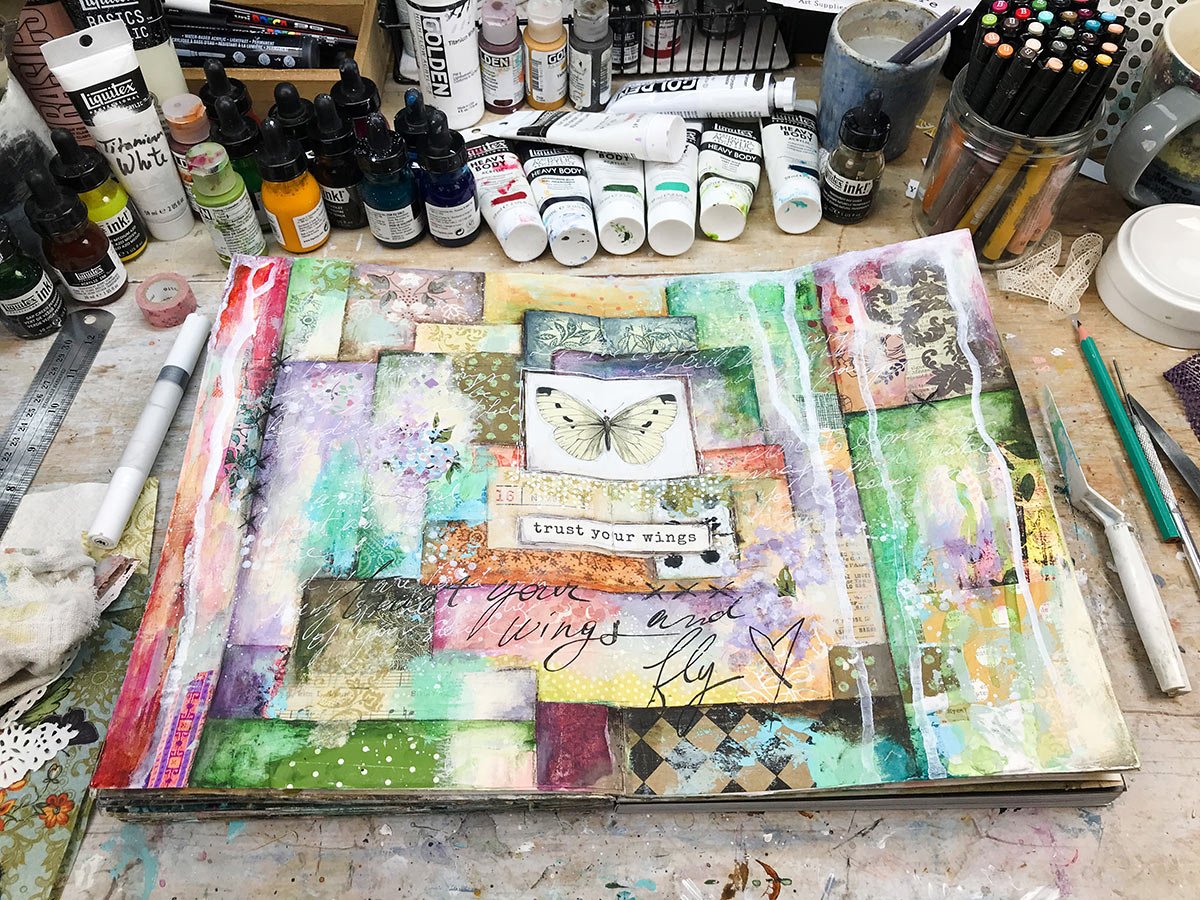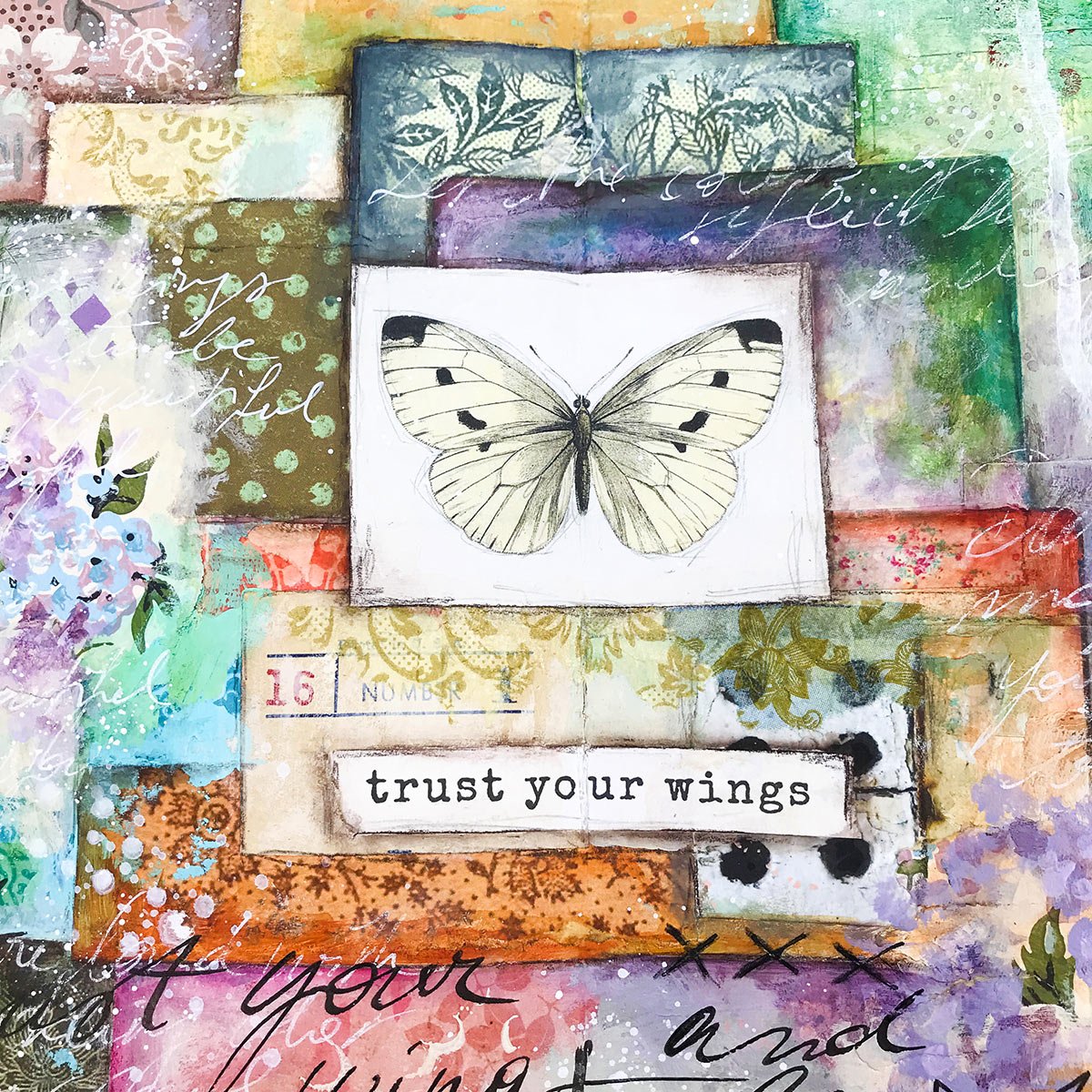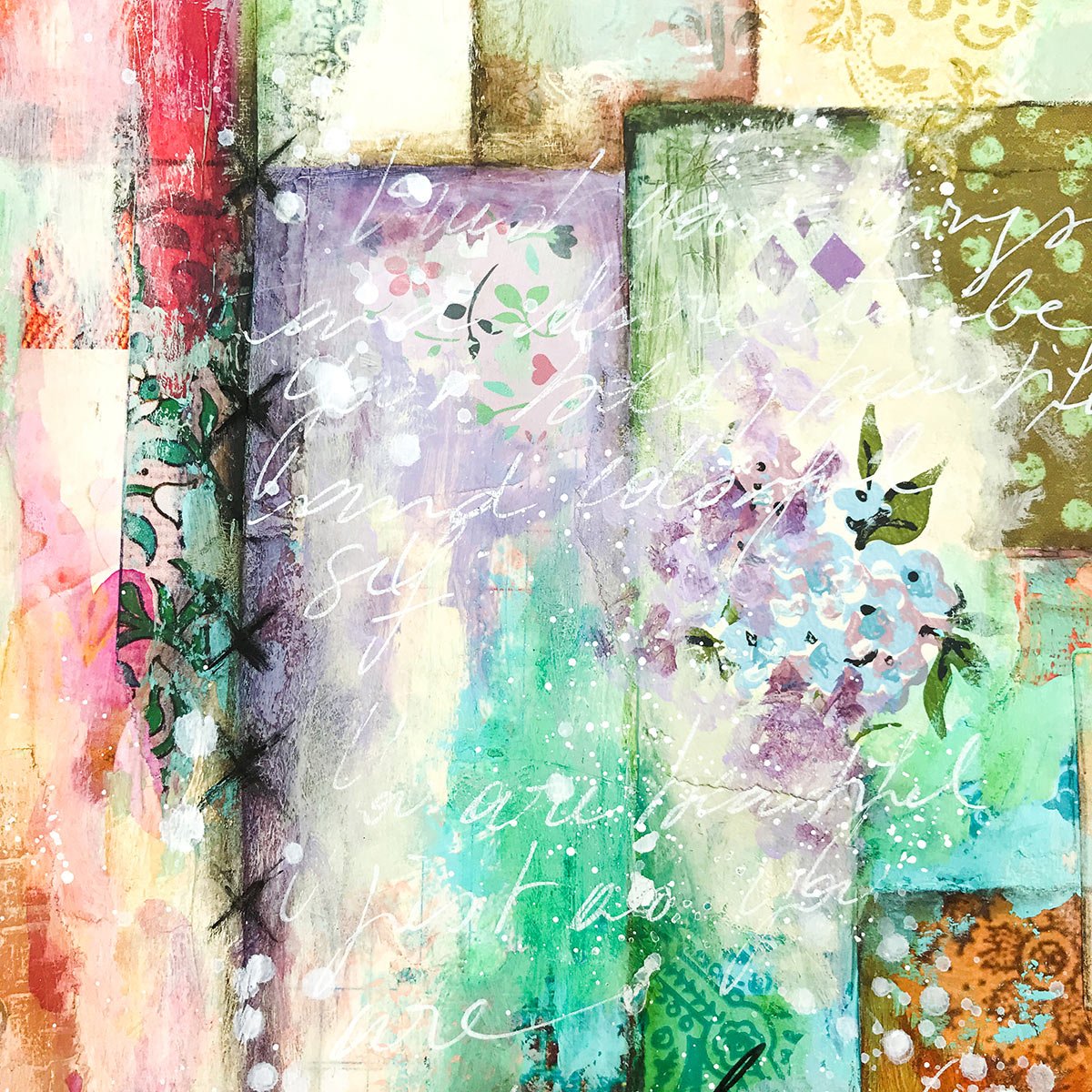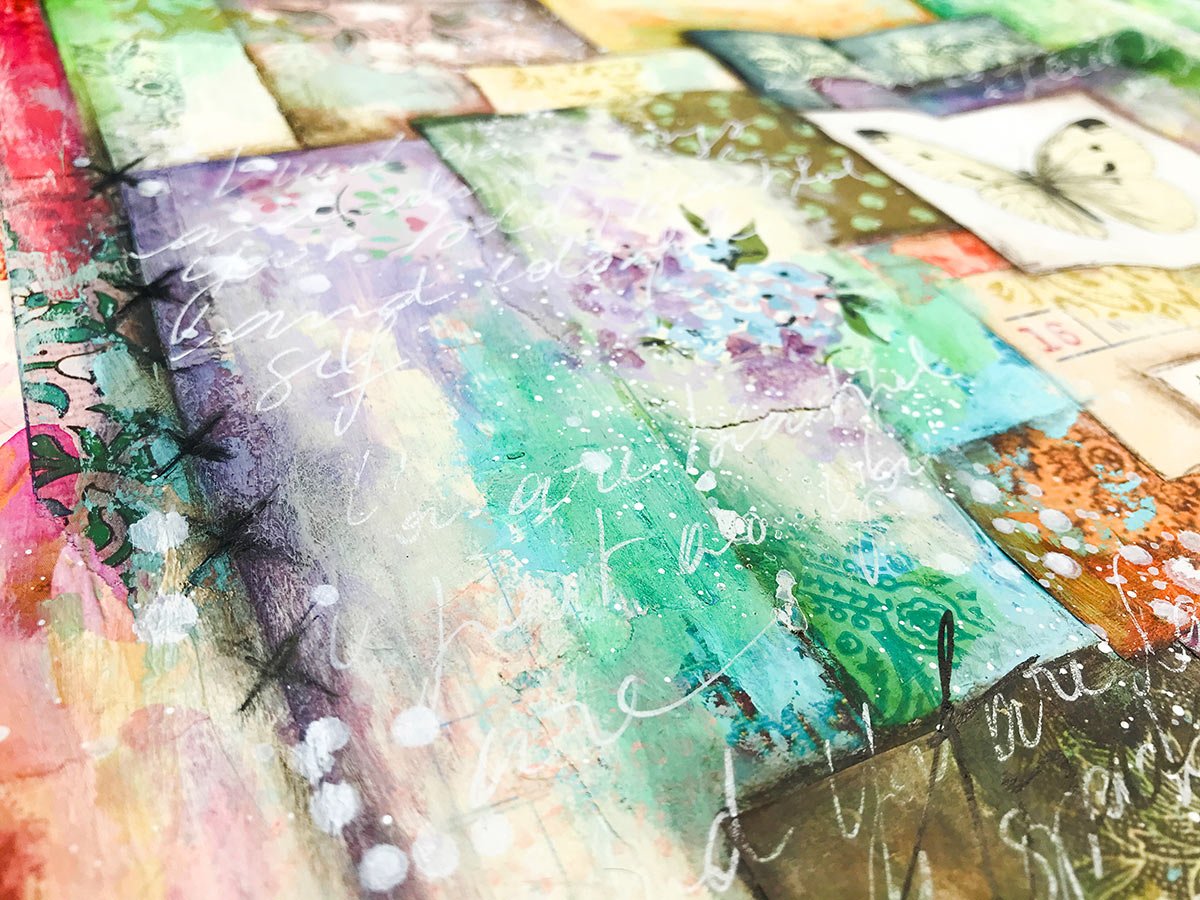Using Acrylics Mindfully
5 favorite tips to
use acrylics mindfully
Hello beautiful artist!
I love to use my journal to just play and try out my supplies. Especially if I’m feeling stuck or uninspired, it helps me get back in the flow in no time. Sometimes I’ll just scribble with a new pen or try out all the colors that come in a set of crayons (by the way, we do all this and more in my free workshop about mixed media supplies!).
These simple, experimental backgrounds are also a great way to get rid of the scary blank page. They become a starting point to then journal over and create a visual story. This is exactly what happened in the page I’m sharing today! I created it for a lesson in Wanderlust 2022 on the theme of artist acrylics.
As an eco-conscious person and artist, I’ll admit I have conflicted feelings towards acrylics, yet I can’t really do without them (at least for now). I’m sure I’m not the only one so I thought it would be a great opportunity to talk about it here on the blog, and share my best tips for a more sustainable practice. Then I hope you’ll share yours in the comments!
let's talk about acrylics
When it comes to paint, let’s face it, acrylics are not the most earth-friendly option. There, I said it. Acrylic is basically a form of plastic, so definitely not as natural as watercolor or oils (or my latest obsession: milk paint!). For the past year I’ve been exploring all kinds of more natural paints but the truth is that for now, I haven’t found anything quite as versatile as acrylics, either for paints, or for collage with matte gel medium.
Acrylics dry quickly, and they’re permanent once dry, which is perfect for mixed media layering. Especially the translucent ones that I love to layer over collage. They’re also more practical in my art journal where I often work on several pages at a time and can’t leave it open to dry for hours or even days at a time. So what if there was a way to use acrylics more sustainably?
a more sustainable approach
In many aspects of my art practice, and in our business and everyday life as a family, we’ve made lots of choices over the years to limit our carbon foot-print. We hardly use anything disposable, we eat mostly fresh, homemade and local food, William and I are vegetarians, and our daughter is well on her way. We buy second-hand or from ethical brands, we wrap presents in fabric, we carbon-compensate our website and online classes, we donate to wildlife and environmental organizations and I could go on and on about the hundreds of little things we do or the habits we have let go of. So of course it bothers me to still be using acrylics!
But it also reminds me that we’ll never get it all perfect. In fact, just like in art, perfectionism is a sure way to get stuck and unhappy, and I have to remind myself that doing what I can is already good enough. And I have developped a not-perfect-but-good-enough-for-now approach to acrylics and I thought I’d share all my 5 best tips with you!
favorite tips
Here are the different ways that I try to use acrylics more mindfully. I hope these tips will inspire you, and would love to hear about any other ideas!
#1 Use what you’ve got
For acrylics just as for anything else, the best thing you can do for the planet is always to use what you already have before you go buy something else. Even if you wanted to completely change your practice and say, switch to oils and ditch all your acrylics, that would have more of a negative impact than using the paints you already have, first. Plus you can’t recycle acrylics, so you’d better use them!
Personally, I’ve committed to not buying any more acrylics. A tube will usually last me years, so I will probably still be painting with this medium for a long time, and who knows, maybe by then there will be new kinds of acrylic that are not derived from petrochemicals. Fingers crossed!
#2.Don’t waste it
It has never made sense to me to waste paint, and I definitely want to limit what goes down the drain as much as possible. So I always have a spare canvas or a page in my journal at the ready, where I will quickly spread any left-overs at the end of a session: paint, gesso, gel medium, ink… they all turn into yummy under-layers for future work!
#3. Use good quality paints:
Professional-grade, artist acrylics have a higher ratio of pigment, and better-quality pigment so they are much more statisfying to use, with super beautiful, vibrant colors, and a little goes a loooong way. For the same budget, I’d rather buy just a few quality paints in colors I really love, than a whole lot of student-grade or craft paints. And I like the smaller tubes and bottles because they fit easily on my table!
My only exception is for the neutral colors I use a lot, like Titan Buff, Parchment, or Neutral Gray. Basically they are white paint mixed with just a little bit of color so I don’t need the professional kind, and I use them a lot for backgrounds, veiled effects or to paint the edges of my canvas.
#4. Go local
It’s worth taking the time to research where your paints are made. Ideally, I try not to buy paints that have travelled across the globe to reach me. Here in France, I’m a little spoiled with Liquitex and Sennelier, two really good brands. The Liquitex factory is just an hour’s drive from where I live in the Loire Valley, and Sennelier is in Brittany, so not very far either. But if, for instance, you live in the US, then it makes sense to go for an American brand, like Golden for instance. Of course, I will make an exception for a color I really love and use a lot, like Raw Umber by Golden. The point is just to be mindful, do your research and make choices you’re happy with.
#5. Think outside of the box
Acrylics come in many forms: heavy body, fluid, ink/high flow but also in less obvious supplies like paint markers! For years I have been using Posca pens, but it bothers me to throw away a perfectly good pen once it’s empty, or worse, when the tip gets clogged and you can’t use it anymore even though there’s still plenty of ink inside!
But once again, a little bit of research is the key: first, when you remember that acrylics dry super fast, you realize that if you store your paint markers vertically, with the tip pointing up, then there’s a pretty good chance that it will quickly dry up and get clogged, whereas if you store them horizontally, the nib will always be “bathed” in fluid ink, preventing it from drying!
Also, there are brands that will allow you to replace the nib if needed, and to refill your markers so they will last much longer (plus you can even fill them with your own color mix!). My favorite brand is Molotow, it’s German so still not too far from me and the colors are super high quality.
Of course, it’s not just about acrylics and there are plenty more ways to make your creative practice more sustainable. Ultimately, making your art practice more sustainable is a matter of taking the time, assessing your needs and doing a bit of research. And above all keep focusing on what brings you joy because this is how you will make art that’s full of good vibes!
To find out more about acrylics and all my favorite mixed media supplies, make sure to join my FREE workshop below:
make friends with your art supplies!
Unleash the magic of mixed media in your art! In this video series, I share all about my favorite supplies, (the basics and much more) + plenty of my best tips: From painting tools and acrylics to gesso, inks, mark-making and collage, let’s get painting!










